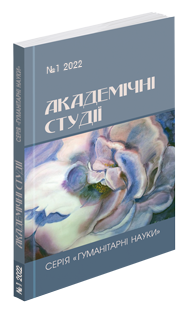Abstract
The article is devoted to the analysis of the linguistic and stylistic and cognitive features of the American comedy film discourse, which is considered to be a combined video-verbal text, dynamically developing in a situation of humorous conversation in a playful manner. Combined with a single topic, plot, situational context with its spatiotemporal characteristics and characters, integrity and coherence, common deep intentions of laughter, play and profanity, humorous or satirical tone, American comedy film discourse is characterized with a diverse arsenal of comic linguistic and extralinguistic nature. The article considers such a cognitive mechanism of comism as the cognitive pattern of distinct contrast, which is an intermediate link between a frame and the cognitive bias of contrast. The basis of this cognitive pattern is formed with the frames of contrasting objects and phenomena, and the value dominant of interest in everything incomprehensible. The involvement of this cognitive pattern is manifested in the fact that contrasting denotates attract more attention and are better remembered by the audience. It has been proven that the actualization of the cognitive pattern of distinct contrast can occur through such stylistic figures as the types of non sequitur, which are accompanied with the switching of logical and unexpected illogical inferences, combined with other stylistic figures as antithesis, metaphor, innuendo, etc., and are applied in American comedy film discourse. Non-sequitur stylistic figures such as ‘Non sequitur awakening’, ‘Non sequitur – bait and switch’, ‘Breathless non-sequitur’, which are used by modern American authors in American comedy film discourse, have been discovered in the American communicative space. The above types of non-sequitur stylistic figures mix such contrasting emotions as excitement and nervousness, joy and disgust, love and hate, laughter and shock, and so on. All these types of non sequitur represent the actualization not only of the cognitive pattern of distinct contrast, but also of the mechanism of associative provocation.
References
Бахтин М. М. Творчество Франсуа Рабле и народная культура Средневековья и Ренесаннса. М. : Мысль, 1979. 280 с.
Самохіна В. О. Сучасний англомовний жарт : монографія. Харків : Харківський національний университет імені В. Н. Каразіна, 2008. 355 с.
Пропп В. Я. Проблемы комизма и смеха. Ритуальный смех в фольклоре (по поводу сказки о Несмеяне). М. : Лабиринт, 1999. 288 с.
Allen W. (1997) Annie Hall. Comedy film. 93 Mn. United artists. USA. URL: http://www.youtube.com/watch?v= K87ct7aP6J0&feature=fvst 5. Allen W. (1971). Bananas. Comedy film. 82 Min-United Artists. USA. URL: http://www.youtube.com/watch?v=rld8hqfoIoQ
Allen W. (1973). Sleeper. Science fiction comedy film. 88Mn. United Artists. URL: http://www.youtube.com/ watch?v=t1shIHF0KJs&feature =related
Darabont F. (1994). The Shawshank Redemption. Drama film .142Mn. Warner Bros. URL: www.youtube.com/results? Search-query=the+shawshank redemption +part+ 1&oq =The+Shawshank+Redemption
Falacci N. (2005). NUMB#RS. Television serial. URL: http:// www.youtube.com/watch? V=cg7v
Gilliam T. (1998). Fear and Loathing in Las Vegas. Black comedy film. 119Mn.Universal Pictures. URL: http://www.youtube.com/watch?v=Zm7r491n-8o
Hobbs T. (1958). Levithan. Parts One and Two. New York : The library of liberal Arts.
Lubitsch E. (1940). The Shop Around the Corner. Comedy film. 99Mn MGM.USA. URL: http://www.youtube.com/ watch?v=CELHxYj6Q3s

